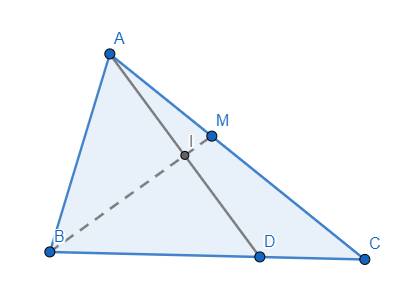Hãy nhập câu hỏi của bạn vào đây, nếu là tài khoản VIP, bạn sẽ được ưu tiên trả lời.

Xét ΔBAD có BI là đường trung tuyến
nên \(\overrightarrow{BI}=\dfrac{1}{2}\left(\overrightarrow{BA}+\overrightarrow{BD}\right)\)
=>\(\overrightarrow{BI}=\dfrac{1}{2}\left(\overrightarrow{BA}+\dfrac{2}{3}\overrightarrow{BC}\right)\)
\(=\dfrac{1}{2}\left(\overrightarrow{BA}+\dfrac{2}{3}\overrightarrow{BA}+\dfrac{2}{3}\overrightarrow{AC}\right)\)
\(=\dfrac{1}{2}\left(\dfrac{5}{3}\overrightarrow{BA}+\dfrac{2}{3}\overrightarrow{AC}\right)\)
\(=\dfrac{1}{2}\cdot\dfrac{1}{3}\left(5\overrightarrow{BA}+2\overrightarrow{AC}\right)=\dfrac{1}{6}\left(5\overrightarrow{BA}+2\overrightarrow{AC}\right)=\dfrac{5}{6}\left(\overrightarrow{BA}+\dfrac{2}{5}\overrightarrow{AC}\right)\)
\(\overrightarrow{BM}=\overrightarrow{BA}+\overrightarrow{AM}\)
\(=\overrightarrow{BA}+\dfrac{2}{5}\overrightarrow{AC}\)
=>\(\overrightarrow{BI}=\dfrac{5}{6}\cdot\overrightarrow{BM}\)
=>B,I,M thẳng hàng

Cách 1: Dùng định lý Menelaus đảo:

Từ đề bài, ta có \(\dfrac{BD}{BC}=\dfrac{2}{3}\), \(\dfrac{MC}{MA}=\dfrac{3}{2}\), \(\dfrac{IA}{ID}=1\)
\(\Rightarrow\dfrac{BD}{BC}.\dfrac{MC}{MA}.\dfrac{IA}{ID}=1\)
Theo định lý Menelaus đảo, suy ra B, I, M thẳng hàng.
Cách 2: Dùng vector
Ta có \(\overrightarrow{BI}=\dfrac{1}{2}\left(\overrightarrow{BA}+\overrightarrow{BD}\right)\)
\(=\dfrac{1}{2}\overrightarrow{BA}+\dfrac{1}{2}.\dfrac{2}{3}\overrightarrow{BC}\)
\(=\dfrac{1}{2}\overrightarrow{BA}+\dfrac{1}{3}\overrightarrow{BC}\)
\(=\dfrac{1}{6}\left(3\overrightarrow{BA}+2\overrightarrow{BC}\right)\)
Lại có \(\overrightarrow{BM}=\dfrac{MC}{AC}\overrightarrow{BA}+\dfrac{MA}{AC}\overrightarrow{BC}\)
\(=\dfrac{3}{5}\overrightarrow{BA}+\dfrac{2}{5}\overrightarrow{BC}\)
\(=\dfrac{1}{5}\left(3\overrightarrow{BA}+2\overrightarrow{BC}\right)\)
\(=\dfrac{6}{5}.\dfrac{1}{6}\left(3\overrightarrow{BA}+2\overrightarrow{BC}\right)\)
\(=\dfrac{6}{5}\overrightarrow{BI}\)
Vậy \(\overrightarrow{BM}=\dfrac{6}{5}\overrightarrow{BI}\), suy ra B, I, M thẳng hàng.

a: \(\overrightarrow{BK}=\overrightarrow{BA}+\overrightarrow{AK}\)
\(=\overrightarrow{BA}+\dfrac{1}{3}\overrightarrow{AC}\)
\(=\overrightarrow{BA}-\dfrac{1}{3}\overrightarrow{BA}+\dfrac{1}{3}\overrightarrow{BC}\)
\(=\dfrac{2}{3}\overrightarrow{BA}+\dfrac{1}{3}\overrightarrow{BC}\)

\(\overrightarrow{IB}+\overrightarrow{IC}+\overrightarrow{IA}\)
\(=\overrightarrow{IB}+2\cdot\overrightarrow{IM}\)
\(=\overrightarrow{IM}\)

Khai thác giả thiết:
+ IA =2IB <=> IA = 2( AB -AI) <=> IA = -2AB <=> AI = 2AB
+ 3JA + 2JC =0 <=> 3JA + 2(JA+ AC) =0 <=> JA = ( -2/5)AC <=> AJ = (2/5) AC
Chỉ ra được vị trí các điểm I, J:
+ I đối xứng với A qua B ( tức B là trung điểm AI)
+ J nằm trên đoạn AC sao cho AJ = 2/5 AC
* Ta có:
+ GI = GA + AI = GA + 2AB
+ GJ = GA + AJ = GA + (2/5) AC
Suy ra:
GI - 5 GJ = -4 GA + 2(AB - AC) = -4GA + 2CB = -4GA + 2(GB -GC)
= -2GA +4GB ( chỗ này có áp dụng tính chất trọng tâm: GA +GB + GC =0)
Do B là trung điểm của AI => 2GB = GA +GI
Suy ra:
GI - 5 GJ = -2GA + 2GA + 2 GI
=> GI = - 5 GJ
Đẳng thức này suy ra I, J, G thẳng hàng => IJ đi qua G (đpcm)
I, J, G thẳng hàng
Do I đối xứng A qua B \(\Rightarrow\overrightarrow{AI}=2\overrightarrow{AB}\)
Do G là trọng tâm tam giác \(\Rightarrow\overrightarrow{AG}=\dfrac{1}{3}\left(\overrightarrow{AB}+\overrightarrow{AC}\right)\)
\(\Rightarrow\overrightarrow{GA}=-\dfrac{1}{3}\overrightarrow{AB}-\dfrac{1}{3}\overrightarrow{AC}\)
a.
\(\overrightarrow{GI}=\overrightarrow{GA}+\overrightarrow{AI}=-\dfrac{1}{3}\overrightarrow{AB}-\dfrac{1}{3}\overrightarrow{AC}+2\overrightarrow{AB}=\dfrac{5}{3}\overrightarrow{AB}-\dfrac{1}{3}\overrightarrow{AC}\)
b.
\(\overrightarrow{AJ}=\dfrac{2}{3}\overrightarrow{JC}=\dfrac{2}{3}\overrightarrow{JA}+\dfrac{2}{3}\overrightarrow{AC}\Rightarrow\dfrac{5}{3}\overrightarrow{AJ}=\dfrac{2}{3}\overrightarrow{AC}\)
\(\Rightarrow\overrightarrow{AJ}=\dfrac{2}{5}\overrightarrow{AC}\)
\(\Rightarrow\overrightarrow{AG}+\overrightarrow{GJ}=\dfrac{2}{5}\overrightarrow{AC}\Rightarrow\dfrac{1}{3}\overrightarrow{AB}+\dfrac{1}{3}\overrightarrow{AC}+\overrightarrow{GJ}=\dfrac{2}{5}\overrightarrow{AC}\)
\(\Rightarrow\overrightarrow{GJ}=-\dfrac{1}{3}\overrightarrow{AB}+\dfrac{1}{15}\overrightarrow{AC}=-\dfrac{1}{5}\left(\dfrac{5}{3}\overrightarrow{AB}-\dfrac{1}{3}\overrightarrow{AC}\right)=-\dfrac{1}{5}\overrightarrow{GI}\)
\(\Rightarrow\) G,I,J thẳng hàng